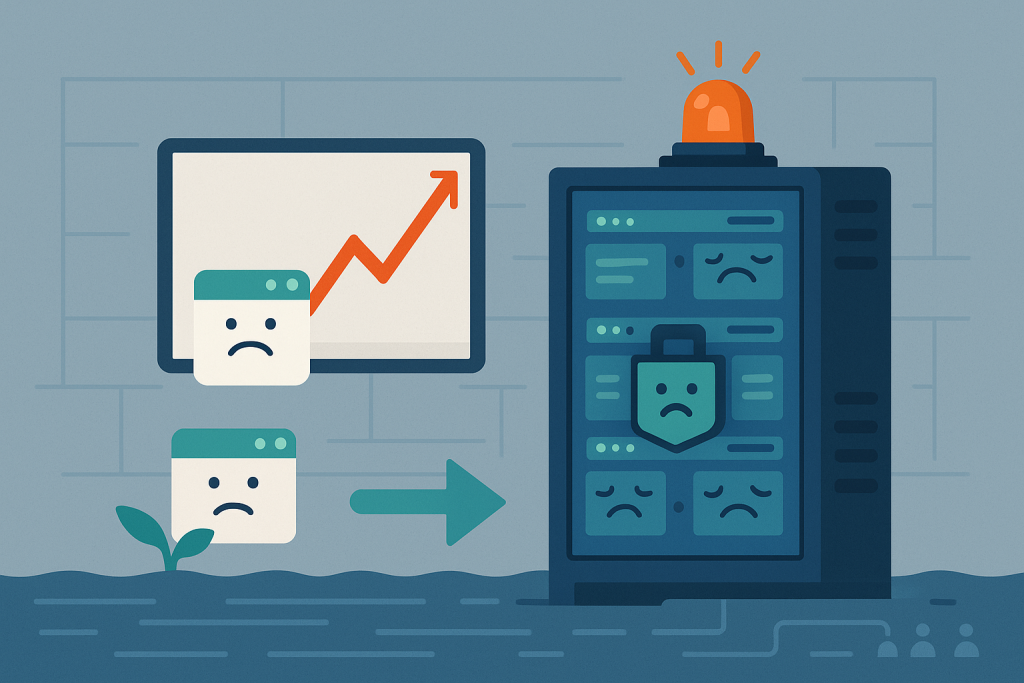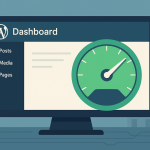In the world of websites, a traffic spike is the ultimate double-edged sword.
On one hand, it’s a moment of triumph: your product is a hit, your blog post went viral, or your marketing campaign is paying off better than you ever dreamed. It’s proof that what you’re doing is working. You feel a rush of excitement, like a sprinter hearing the starting gun.
But on the other hand, the very mention of a sudden, huge wave of visitors sends a shiver down the spine of anyone running a website on a standard Shared Hosting plan. This is where the triumph can turn into a technical disaster.
The reality is that shared hosting—the most popular, affordable, and beginner-friendly type of web hosting—was not designed for viral moments. It was built for stability, affordability, and moderate, predictable traffic. When an unexpected army of visitors arrives, the cracks in the foundation begin to show.
This post isn’t about scaring you into an expensive upgrade. It’s about giving you the real, honest, and detailed insights into what actually happens when your shared server experiences a traffic spike. We’ll explore the technical limits that are often hidden in the fine print and, more importantly, give you a detailed action plan to prepare your current setup so you can survive the spike and turn a moment of chaos into a genuine opportunity for growth.
1. The Core Problem: The Shared Ecosystem
To understand how a shared server handles a traffic spike, you must first understand its fundamental nature. Think of shared hosting not as a single home, but as a busy, high-rise apartment building.
| Feature | The Apartment Analogy | The Shared Hosting Reality |
| The Building | The entire physical structure (pipes, electricity, elevator). | The single, physical server (the hard drives, the motherboard, the network card). |
| The Tenants | All the individual apartments/residents. | The hundreds, sometimes thousands, of individual websites. |
| Shared Resource | The single water pipe, the single elevator, the shared electricity grid. | The CPU (Processor), RAM (Memory), and I/O (Input/Output) Speed. |
In this building, everyone is pooling their resources to keep the cost low. Most of the time, the elevator is free, the water pressure is good, and the lights stay on. Everyone is happy because everyone is using the resources moderately.
The Resource Contention Nightmare
A traffic spike on your website is like one apartment in the building suddenly deciding to run ten washing machines, two dishwashers, and three long showers all at once.
- CPU (The Server’s Brain): Every visitor request (loading a page, logging in, searching the site) needs the CPU to “think” and process. During a spike, the queue of requests grows instantly. Your site might start using 50% of the available CPU time on the entire server. This leaves the CPU with less power to handle requests for the other 400 websites on the server. Result: Everything slows down.
- RAM (The Server’s Short-Term Memory): RAM is used to quickly access data. When a script runs (like a WordPress plugin or a database query), it uses RAM. A spike means hundreds of simultaneous processes are fighting for the same limited pool of RAM. Result: The server has to start using slower virtual memory (swap space) or, worse, the processes simply fail, leading to an Internal Server Error (500 Error).
- I/O (Input/Output – The Hard Drive Speed): This is how fast the server can read and write data from the hard drive (e.g., getting your website files or fetching data from the database). A massive number of simultaneous requests to the disk can instantly overwhelm the I/O capacity, which is one of the tightest bottlenecks on a shared server. Result: Pages take a very long time to load or fail completely with a Gateway Timeout (504 Error).
This is the key insight: When your site spikes, it doesn’t just affect your site; it stresses the entire shared server environment, which is why hosting providers must intervene.
2. The Unwritten Rules: Shared Hosting’s Hard Limits
Shared hosting isn’t truly unlimited, even if the marketing says “unlimited bandwidth” or “unlimited disk space.” These terms refer to predictable, low-to-moderate usage. The real limits are technical constraints enforced by the server operating system, usually via a technology like CloudLinux.
These limits are designed to protect the other “tenants” in the building from a resource hog.
A Deeper Look at the Common Limits
| Limit Type | What It Means | Real-World Consequence During a Spike |
| CPU Cores/Time | Your website is only allowed to use a small fraction of the total CPU power (e.g., 10% of one core). | Hitting the limit means your processes are paused or “throttled.” Pages that should load in 1 second now take 5-10 seconds, or more. |
| Physical Memory (RAM) | The actual memory your scripts can consume (often 512 MB to 1 GB per account). | If your sudden traffic needs 1.2 GB of memory, your server processes will be “killed” automatically by the operating system. This is a guaranteed 500 or 503 Service Unavailable error. |
| I/O Throughput | The read/write speed to the disk, often capped at 1-10 MB/s. | The database can’t read and write fast enough to serve page content to all visitors simultaneously. Your site slows to a crawl even if you have available CPU/RAM. |
| Entry Processes (EP) | The number of simultaneous PHP scripts (visits) the server will handle for your account. Usually limited to 20 to 50. | If your limit is 20, and 21 people arrive at the same time, the 21st person will see a “508 Resource Limit Reached” error. This is the most common cause of shared hosting crashes during a spike. |
The Host’s Response: What Happens Next
When your site consistently exceeds these “soft” limits, one of a few things will happen, usually in this order:
- Immediate Throttling: The CloudLinux system on the server automatically slows down your website’s processes to keep the overall server stable. Your site becomes incredibly slow.
- Resource Limit Error (508): As the Entry Process limit is hit, new visitors are simply rejected by the server and see an error page.
- Suspension Notice (The “Naughty List”): If the spike is prolonged (hours or days) and you keep hitting the hard limits, the hosting provider’s automated monitoring system will flag your account. They will send you an email asking you to either optimize your site or upgrade your plan. In the most severe cases of server instability, they may temporarily suspend your account to protect the hundreds of other sites.
This is the harsh but genuine truth: Your shared hosting plan has a hidden visitor capacity, and a sudden spike is the fastest way to find it.
3. The Shared Hosting Survival Guide: How to Prepare
The good news is that you can dramatically increase your shared server’s spike tolerance by optimizing your website to use fewer resources for each visitor. If a single visitor request uses 10 units of resource, and you optimize it to use 1 unit, your server can now handle ten times the number of visitors!
Here is the detailed, actionable plan for making your shared hosting account spike-ready.
Strategy 1: Deploy a Caching Powerhouse
Caching is the single most important defense against a traffic spike. It’s the equivalent of printing out a million copies of your apartment’s blueprints so the elevator doesn’t have to go back to the architect’s office every time a tenant needs to know where their kitchen is.
- What it does: Caching saves a finished, pre-built version of your webpage (mostly for visitors who are not logged in). When a new person visits, the server skips all the slow, CPU-intensive steps—running PHP, querying the database—and just delivers the saved HTML file.
- Actionable Steps:
- Install a Robust Caching Plugin: For WordPress, use plugins like WP Rocket (paid, best performance), LiteSpeed Cache (if your host supports LiteSpeed), or W3 Total Cache.
- Focus on Server-Side Caching: Ensure your plugin or host is enabling Object Caching (for database queries) and Browser Caching (so returning visitors load static files like images instantly).
- Crucial Step: Check Your Caching Hit Rate. After setting up, check if your caching system is actually working. Ideally, 80%−95% of your page views should be served directly from the cache, bypassing the server’s CPU and RAM.
Strategy 2: Offload Static Assets with a CDN
A Content Delivery Network (CDN) is a global network of servers that stores copies of your website’s static files (images, CSS stylesheets, JavaScript files).
- What it does: A CDN acts as a worldwide army of resource offloaders. When a visitor comes to your site, instead of your shared server sending the 50 image files, the CDN sends those files from a server that is geographically closer to the visitor.
- Actionable Steps:
- Sign up for a Free or Affordable CDN: Cloudflare has an excellent free plan that works wonders. Other options include KeyCDN or StackPath.
- Activate Cloudflare’s Caching and Optimization: Make sure you turn on features like Minification (compresses your code) and Rocket Loader (optimizes how scripts are loaded). This not only speeds up your site but also acts as a primary firewall, filtering out bad bot traffic before it ever reaches your shared host.
- Impact: A well-configured CDN can offload 60% to 80% of the requests hitting your origin server, effectively giving your shared hosting a massive, instant resource upgrade for free.
Strategy 3: Lightweight Everything
Every theme, every plugin, and every image is a resource cost. During a spike, these costs multiply by the number of simultaneous visitors.
- Actionable Steps:
- Review and Cull Plugins: Go through your installed plugins and delete any you don’t actively use. Even inactive plugins can sometimes run background scripts. Replace bloated plugins with lighter alternatives.
- Image Optimization: Compress all your images using tools like ShortPixel, Imagify, or TinyPNG before uploading them. Use the WebP format if your site supports it, as it’s a huge file size reduction.
- Use a Lightweight Theme: Themes like Astra, GeneratePress, or Kadence are optimized to use minimal code, meaning they make fewer, faster database queries, which is vital during a traffic surge.
- Database Cleaning: Use a tool like WP-Optimize to regularly clean up post revisions, spam comments, and orphaned data in your database. A lean database is a fast database.
4. The Real Limits: When You Must Upgrade
Despite all the optimization in the world, there comes a point when a shared hosting server simply cannot handle the load, and it’s time to move. A successful spike that turns into sustained high traffic is the clearest sign.
Signs You’ve Outgrown Shared Hosting:
- Consistent 508 or 503 Errors: If your site is optimized, using a CDN, and still throwing “Resource Limit Reached” errors several times a week, you’ve hit your hard limit. The traffic is now sustained at a level too high for the shared pool.
- Regular Host Warnings/Suspensions: If your hosting provider repeatedly emails you about high CPU or I/O usage, they are telling you in no uncertain terms: your site is too big for the shared environment. Ignore these at your peril.
- High-Level E-commerce or Dynamic Needs: Shared hosting is poor for sites where every visitor is doing something unique (e.g., adding an item to a cart, checking inventory, searching a customized database). These dynamic actions can’t be cached and hit the database hard, instantly exceeding the shared limits.
Your Next Steps for Scalability:
When you’re ready to move past shared hosting, you have two primary, affordable options for the next level of scalability:
| Hosting Type | Who It’s For | Key Advantage Over Shared | Spike Handling Capability |
| Virtual Private Server (VPS) | Websites with regular, medium-to-high traffic and e-commerce stores. | Guaranteed Resources. You get a specific amount of CPU and RAM that is yours alone. No one else on the server can touch it. | Excellent. Much higher limit before crashing. Performance is stable and predictable during traffic surges because resources are dedicated. |
| Managed Cloud Hosting | Websites that have unpredictable traffic (viral potential, seasonal spikes). | Auto-Scaling. Resources can be automatically or manually added on demand when a spike occurs, and then scaled back down after. You only pay for the extra resources you use. | Superior. The infrastructure is built to stretch. It’s the closest thing to “unlimited” resource handling, without the risk of a crash, but it can be more expensive. |
For most successful websites leaving the shared environment, a Managed VPS is the perfect middle ground, offering a huge leap in performance, stability, and control without the complexity of a completely unmanaged server.
Conclusion: Turn Spike Stress into Success
Traffic spikes on shared hosting are not a death sentence, but they are a mandatory performance review of your website and your hosting plan.
If your website is well-optimized with layers of caching and a CDN, a shared host can often withstand a surprisingly large, but short-lived, spike of tens of thousands of visitors. The trick is to prevent those visitors from ever needing to talk to your shared server’s CPU and database.
However, if that spike turns into sustained, high traffic, your shared host will eventually buckle under the unyielding pressure of its hard resource limits. At that point, the most human and easiest thing to do is celebrate the success and make the necessary, profitable upgrade.
Prepare for the best, optimize for the worst, and use these real-world insights to ensure your website is ready for its viral moment, whenever it arrives.



